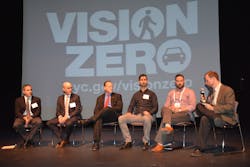QUEENS, NY. When it comes to safety, technology use could end up contradicting itself. The very devices that distract us while we’re behind the wheel – possibly causing fatal crashes – could be the same devices that end up reducing injuries and saving lives.
During a Vision Zero Fleet Safety Forum on Nov. 5, a panel of technology experts discussed how the use of certain technologies could help eliminate vehicle-related fatalities and major injuries.
Panelists were:
- Michael Backman, vice president and general manager of U.S. operations at Mobileye, which develops collision avoidance systems based on artificial vision and adaptive cruise control.
- Ben Englander, vice president of engineering at Rosco Vision Systems, a supplier of backup camera systems, mirrors, and visors for the commercial vehicle market.
- Jon Coleman, fleet sustainability and technology manager at Ford Motor Co.
- Jonathan Matus, CEO and founder of Zendrive, which uses sensors on a smartphone to measure drivers’ behaviors.
- Michael Rosen, business development manager of Thermopylae Sciences, which offers web-based geospatial capabilities, mobile software framework and apps, and cloud computing.
Backman noted that every year in the U.S., around 33,000 people die in preventable crashes. He added that 93% of all accidents are due to human error, with driver inattention being the primary cause. He also mentioned that 74% of all accidents include drivers’ inattention in the three seconds preceding the accident.
That’s where Mobileye comes in, he said.
Mobileye’s technology involves a vision sensor atop the windshield that looks out at the road in real-time, artificial vision. According to Backman, the system identifies potential threats, pedestrians, unintentional lane departures, speeding and tailgating and alerts the driver when risky events or behaviors occur.
“Something like this can really help a driver if they’re intentionally doing something wrong like texting or if they’re cognitively distracted – such as looking at the windshield but not paying attention,” Backman explained.
Rosco Vision Systems, which recently integrated with Mobileye and developed its Shield+ technology, displays an alert in the vehicle when a pedestrian is present. Englander explained that the technology helps with what he calls the “enemies of awareness” – obstructions and blind spots.
Englander explained Shield+ maps out hot spots on driving routes and uses 360-deg. view external cameras to provide drivers a full view around the camera.
When it comes to integrating the technology and Vision Zero’s safety mission on the OEM side, Coleman explained that one of the biggest challenges for automotive manufacturers is population growth and more vehicles on the road.
“A lot of the issues that relate to safety have to do with congestion and people not knowing what the traffic is going to do,” Coleman said. “Do we design vehicles for the occupants, operators, or the asset owner? How the vehicle integrates with the environment becomes very important.”
Zendrive might be able to help with that congestion problem. According to Matus, the purpose of Zendrive is to make all roads and drivers safe through data and analytics via smartphones. The technology uses a smartphone’s sensor to pick up GPS and acceleration measurements to collect data relevant to driving risk.
Matus added that Zendrive also collects, layers and aggregates data in a way that can help fleets and the public prevent fatalities. The information, he said, can be shared with cities and communities for policy-making decisions.
“It is making the smartphone, which is the thing distracting us on the road, to save lives,” Matus said. “It can detect phone use/distracted driving and works to influence driver behavior. If you can reduce phone use by 60%, imagine what impact it has on pedestrians in the city and insurance liabilities.”
And when it comes to analyzing data and putting it to use, Rosen believes Thermopylae Sciences helps customers visualize data in a way that it makes more sense. The idea, he said, is “How can we make the data be more relevant in our lives and make us make better business decisions that can generally save our lives?”
For instance, Rosen said his company has worked with Google to integrate railroad crossings in its maps to provide visual and audio alerts when drivers approach high-risk areas. The technology, he said, can help businesses and drivers make preventative decisions to help save lives.
Potential barriers
When it comes to the barriers to some of these safety technologies reaching their full potential, Matus of Zendrive said: “The one thing that will not change is that they all already have a smartphone and could be distracted by their smartphone. But we can use technology as a powerful intermediary until cars help drivers become much safer.”
Though many new technologies are being proposed – autonomous vehicles, V2V communication, or vehicle to infrastructure communication – Backman said there is no need to wait to implement other technology that can be retrofitted to any vehicle now.
“Something that is a harsh reality to absorb is that the vast majority of drivers want to be distracted,” Coleman said. “If they didn’t they’d turn their phone off.”
Coleman suggested figuring out ways to make cell phone use while driving more socially unacceptable – like we did with drunk driving. In addition, he said, the more features we put on vehicles to minimize people who want to be distracted, the more reliant they could become, which could make things worse.
“Those are the obstacles,” Coleman said. “We need to get the city of New York to accept the fact that distracted driving is socially unaccepted.”
But from a commercial perspective, there is a different mindset when it comes to distracted driving and safety technology, Englander pointed out.
“Commercial drivers are going to be important for a very long time,” he said. “How do we make them partners with technology for what they need to do. It’s not a crutch, but a partnership with the technology. We need to provide these professional with tools to make them better and to make their jobs easier to perform.”
About the Author

Cristina Commendatore
Cristina Commendatore is a past FleetOwner editor-in-chief. She wrote for the publication from 2015 to 2023.
